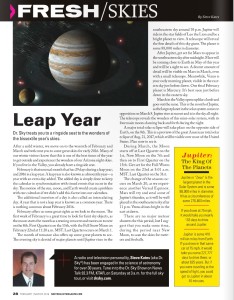A ringside seat to the wonders of the Valley skies
Dr. Sky treats you to a ringside seat to the wonders of the bissextile year’s skies.
After a mild winter, we move on to the warmth of February and March and welcome you to some great skies for early 2016. Many of our winter visitors know that this is one of the best times of the year to get outside and experience the wonders of our Arizona night skies. If you live in the Valley, you already have a ringside seat.
February is that unusual month that has 29 days during a leap year; and 2016 is a leap year. A leap year is also known as a bissextile year––a year with an extra day added. The added day is simply done to keep the calendar in synchronization with timed events that occur in the sky. The motion of the sun, moon, and Earth would create a problem with our calendars if we didn’t add this factor into our calendars.
The additional insertion of a day is also called an intercalating day. A year that is not a leap year is known as a common year. There is nothing common about February 2016.
February offers us some great sights as we look to the moon. The first week of February is a great time to look for faint sky objects, as the moon starts the month as a waning crescent and moves on to new on the 8th. First Quarter is on the 15th, with the Full Snow Moon on February 22nd at 11:20 a.m. MST. Last Quarter occurs on March 1.
The month of romance also offers up some great planets to see. The evening sky is devoid of major planets until Jupiter rises in the southeastern sky around 10 p.m. Jupiter will ride in the star fields of Leo the Lion and be a bright planet to view. A telescope will reveal the fine details of this sky giant. The planet is some 88,000 miles in diameter.
After Jupiter, get set for Mars to appear in the southeastern sky after midnight. Mars will be coming close to Earth in May of this year and will be a sight to see. A decent amount of detail will be visible on Mars in March, even with a small telescope. Meanwhile, Venus is your early morning planet, visible in the eastern sky just before dawn. One final February planet is Mercury. It’s best seen just before dawn in the eastern sky.
March in the Valley opens up like a lamb and goes out the same. This is the month of Jupiter, as the largest planet in the solar system comes to opposition on March 8. Jupiter rises at sunset and is in the sky all night. The telescope reveals the wonders of this mini-solar system, with its four main moons dancing back and forth during the night.
A major total solar eclipse will take place on the opposite side of Earth, on the 8th. This is a preview of the great American total solar eclipse of Aug. 21, 2017, which will be visible over most of the United States. Plan now to see it.
During March, the Moon starts off at Last Quarter on the 1st, New Moon on the 7th and then on to First Quarter on the 15th. Get set for the Full Worm Moon on the 23rd at 5:01 a.m. MST. Last Quarter on the 31st.
The change of the seasons occurs on March 20, as we experience another Vernal Equinox. Mars will try and steal some of Jupiter’s thunder, as it will be well placed in the southeastern sky after 11 p.m. Venus shines bright in the east at dawn.
There are no major meteor showers for this period, but I suggest that you make some time, during the period near New Moon, to scan the skies for meteors and fireballs.
February Trivia
Roman King Numa Pompilius added February to the calendar in 700BC.
The Roman month February was known as “Februum” or Purification.
Jupiter: The King Of The Planets
Jupiter or “Zeus” is the largest planet in the Solar System and is some 88,000 miles in diameter. It has a circumference of some 276,460 miles.
If you drove at 75 mph, it would take you nearly 153 days to drive around Jupiter.
Jupiter will be some 410 million miles from Earth. If you drove in that same car at 75 mph, it would take you some 227,777 days to drive there, or about 625 years. But if you were traveling at the speed of light, you could get to Jupiter in about 45 minutes.
Related posts
Leave a Comment
You must be logged in to post a comment.







